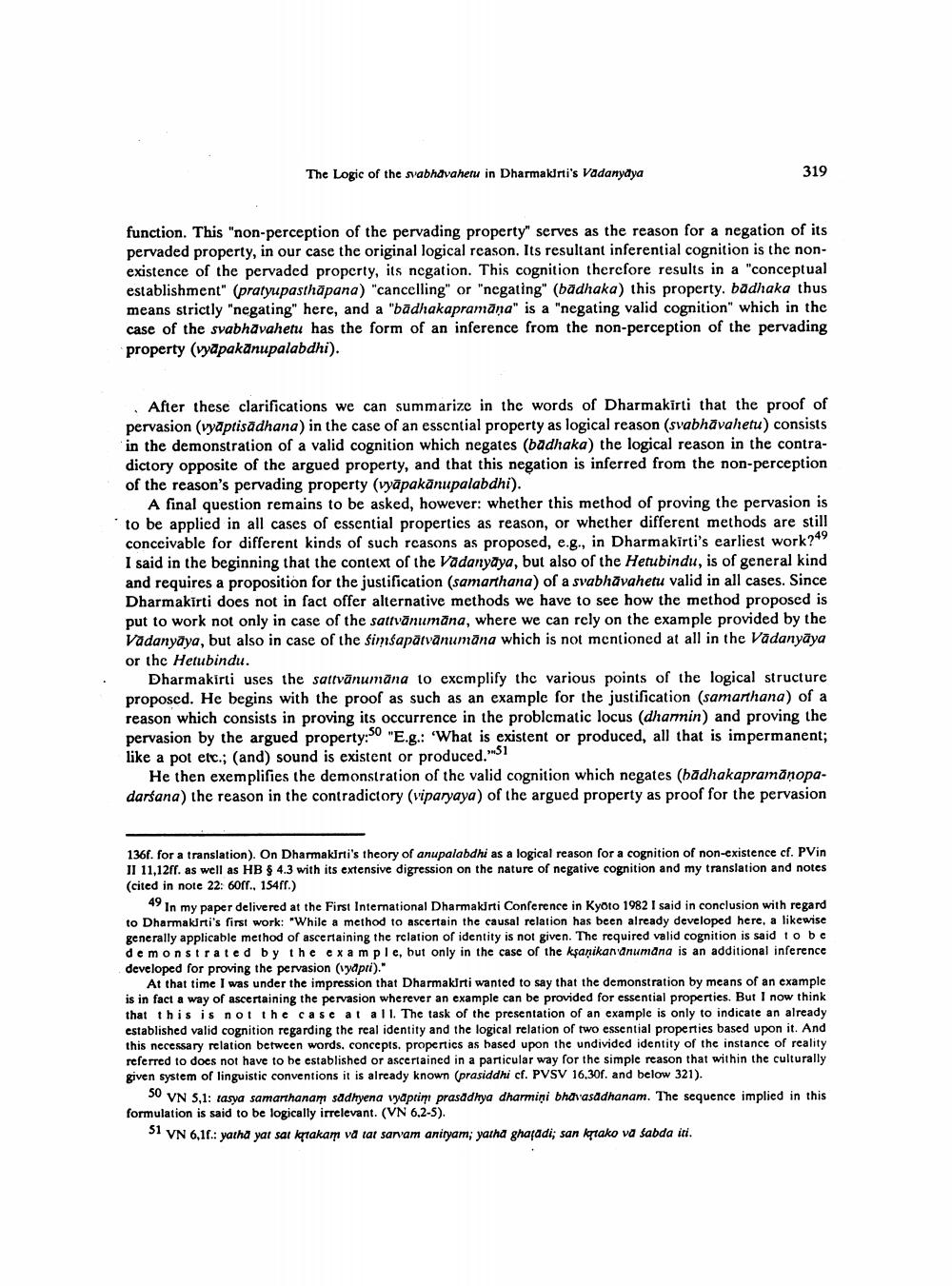Book Title: Logic Of Svabhavahetu In Dhharmakirtis Vadanyaya Author(s): Ernat Steinkellner Publisher: Ernat Steinkellner View full book textPage 9
________________ The Logic of the svabhavahetu in Dharmakirti's Vadanyaya 319 function. This "non-perception of the pervading property" serves as the reason for a negation of its pervaded property, in our case the original logical reason. Its resultant inferential cognition is the nonexistence of the pervaded property, its negation. This cognition therefore results in a "conceptual establishment" (pratyupasthapana) "cancelling" or "negating" (badhaka) this property. badhaka thus means strictly "negating" here, and a "badhakapramāṇa" is a "negating valid cognition" which in the case of the svabhavahetu has the form of an inference from the non-perception of the pervading property (vyāpakānupalabdhi). After these clarifications we can summarize in the words of Dharmakirti that the proof of pervasion (vyaptisadhana) in the case of an essential property as logical reason (svabhavahetu) consists in the demonstration of a valid cognition which negates (badhaka) the logical reason in the contradictory opposite of the argued property, and that this negation is inferred from the non-perception of the reason's pervading property (vyāpakānupalabdhi). A final question remains to be asked, however: whether this method of proving the pervasion is to be applied in all cases of essential properties as reason, or whether different methods are still conceivable for different kinds of such reasons as proposed, e.g., in Dharmakirti's earliest work?49 I said in the beginning that the context of the Vadanyaya, but also of the Hetubindu, is of general kind and requires a proposition for the justification (samarthana) of a svabhavahetu valid in all cases. Since Dharmakirti does not in fact offer alternative methods we have to see how the method proposed is put to work not only in case of the sattvänumāna, where we can rely on the example provided by the Vadanyaya, but also in case of the simsapātvānumāna which is not mentioned at all in the Vadanyāya or the Hetubindu. Dharmakirti uses the sattvānumāna to exemplify the various points of the logical structure proposed. He begins with the proof as such as an example for the justification (samarthana) of a reason which consists in proving its occurrence in the problematic locus (dharmin) and proving the pervasion by the argued property:50 "E.g.: 'What is existent or produced, all that is impermanent; like a pot etc.; (and) sound is existent or produced."51 He then exemplifies the demonstration of the valid cognition which negates (badhakapramāṇopadarśana) the reason in the contradictory (viparyaya) of the argued property as proof for the pervasion 136f. for a translation). On Dharmakirti's theory of anupalabdhi as a logical reason for a cognition of non-existence cf. PVin II 11,12ff. as well as HB § 4.3 with its extensive digression on the nature of negative cognition and my translation and notes (cited in note 22: 60ff., 154ff.) 49 In my paper delivered at the First International Dharmakirti Conference in Kyoto 1982 I said in conclusion with regard to Dharmakirti's first work: "While a method to ascertain the causal relation has been already developed here, a likewise generally applicable method of ascertaining the relation of identity is not given. The required valid cognition is said to be demonstrated by the example, but only in the case of the kşanikaranumāna is an additional inference developed for proving the pervasion (vyapti)." At that time I was under the impression that Dharmakirti wanted to say that the demonstration by means of an example is in fact a way of ascertaining the pervasion wherever an example can be provided for essential properties. But I now think that this is not the case at all. The task of the presentation of an example is only to indicate an already established valid cognition regarding the real identity and the logical relation of two essential properties based upon it. And this necessary relation between words, concepts, properties as based upon the undivided identity of the instance of reality referred to does not have to be established or ascertained in a particular way for the simple reason that within the culturally given system of linguistic conventions it is already known (prasiddhi cf. PVSV 16,30f. and below 321). 50 VN 5,1: tasya samarthanam sadhyena vyaptim prasādhya dharmiņi bhāvasādhanam. The sequence implied in this formulation is said to be logically irrelevant. (VN 6,2-5). 51 VN 6,1f.: yatha yat sat kṛtakam vā tat sarvam anityam; yathā ghaṭādi; san kṛako vā šabda iti.Page Navigation
1 ... 7 8 9 10 11 12 13
